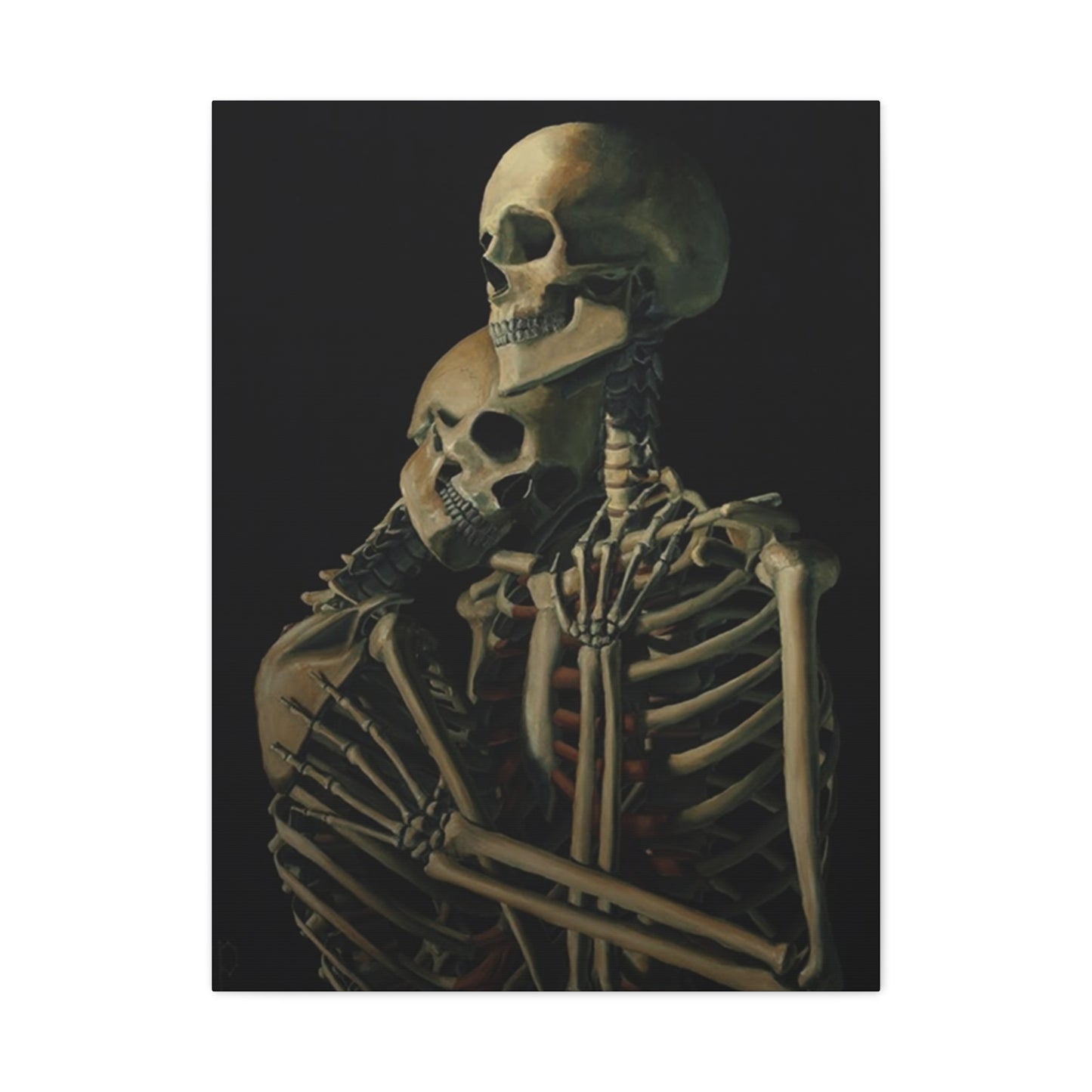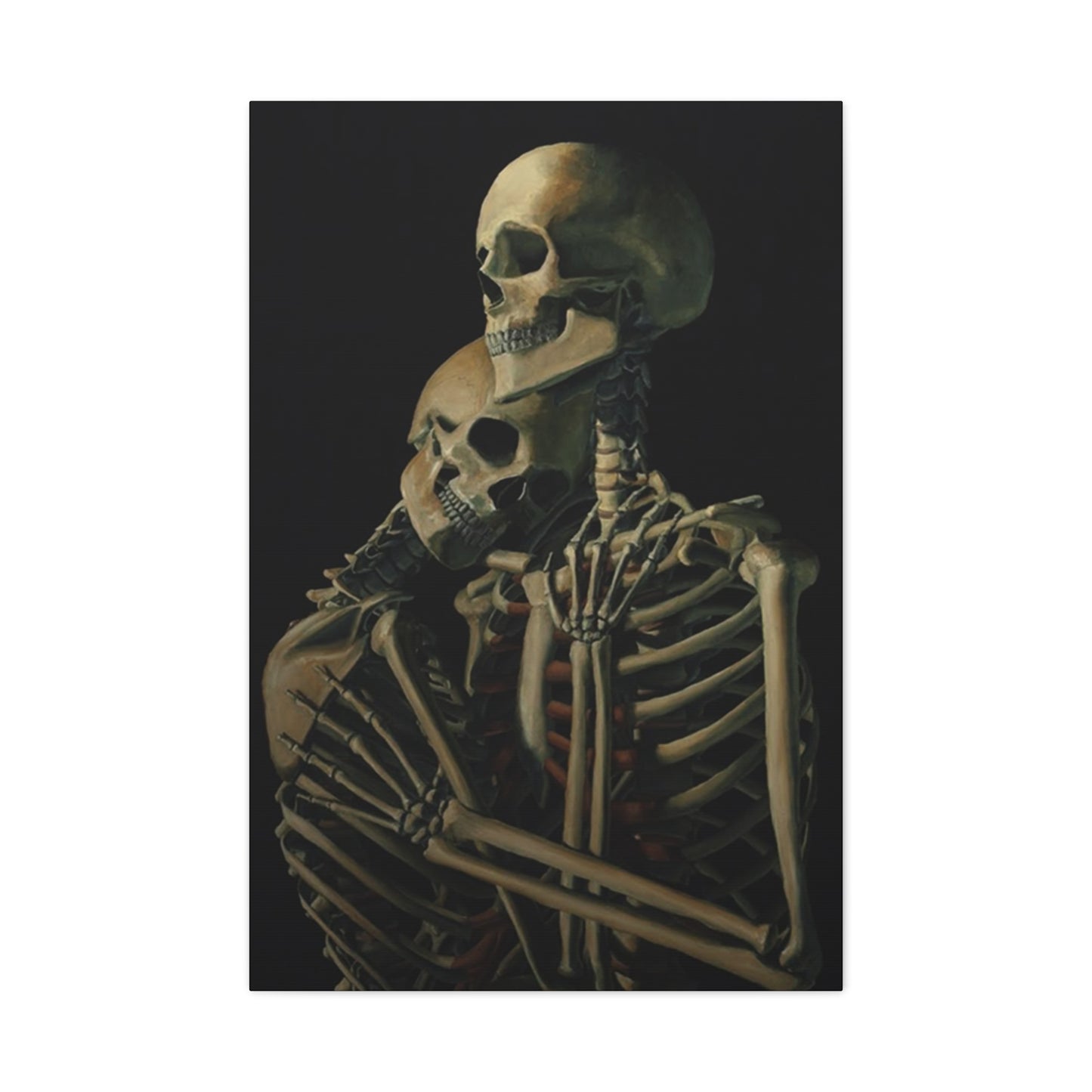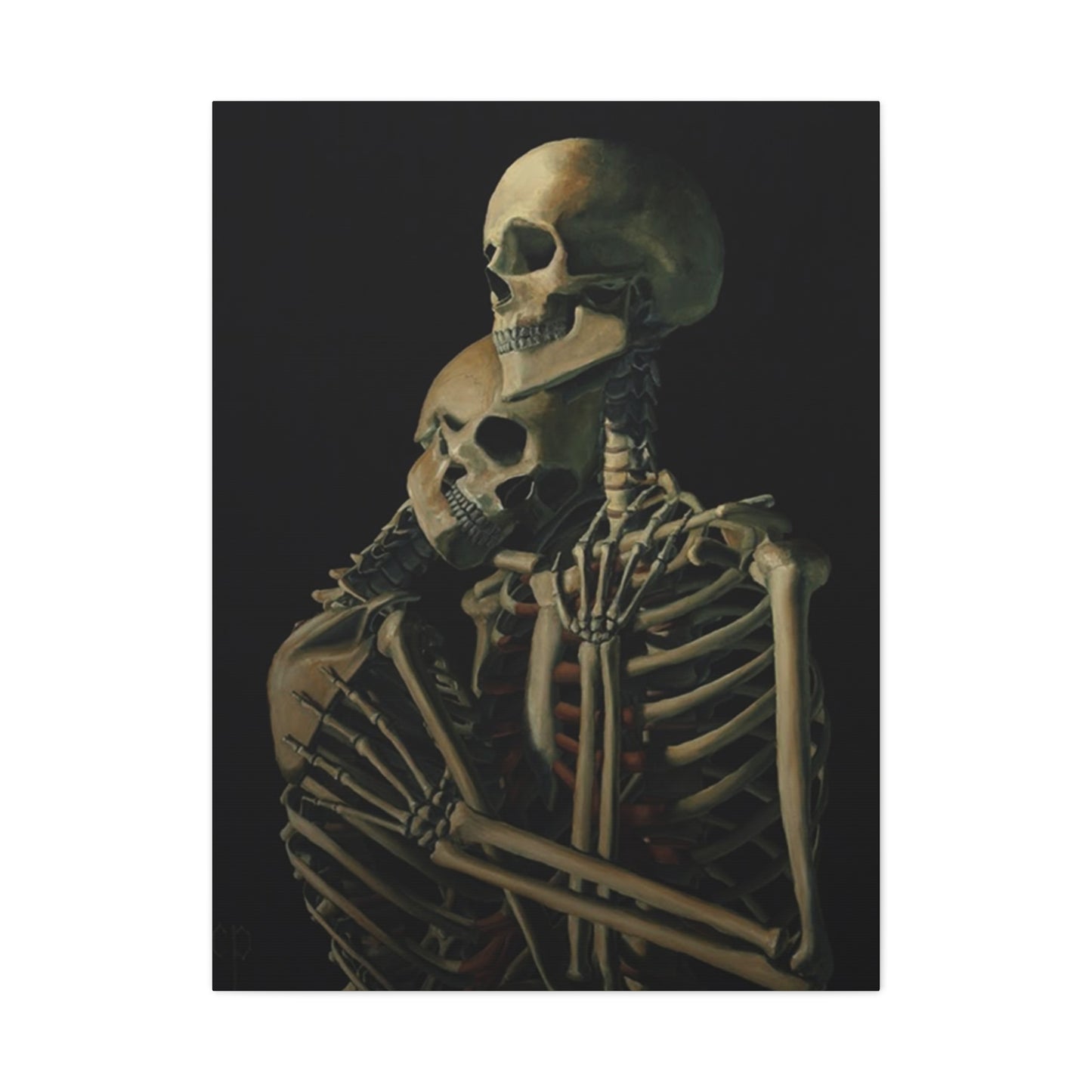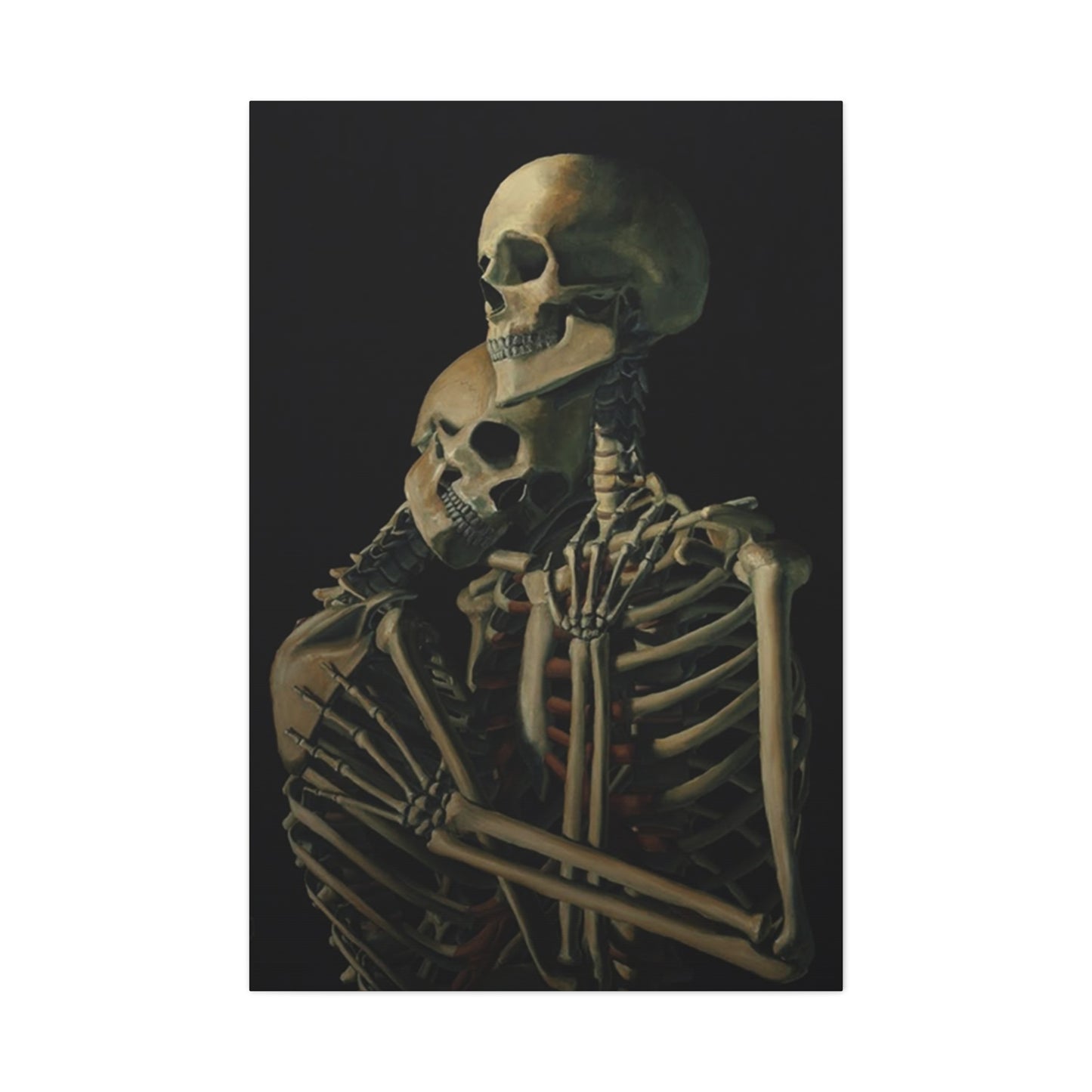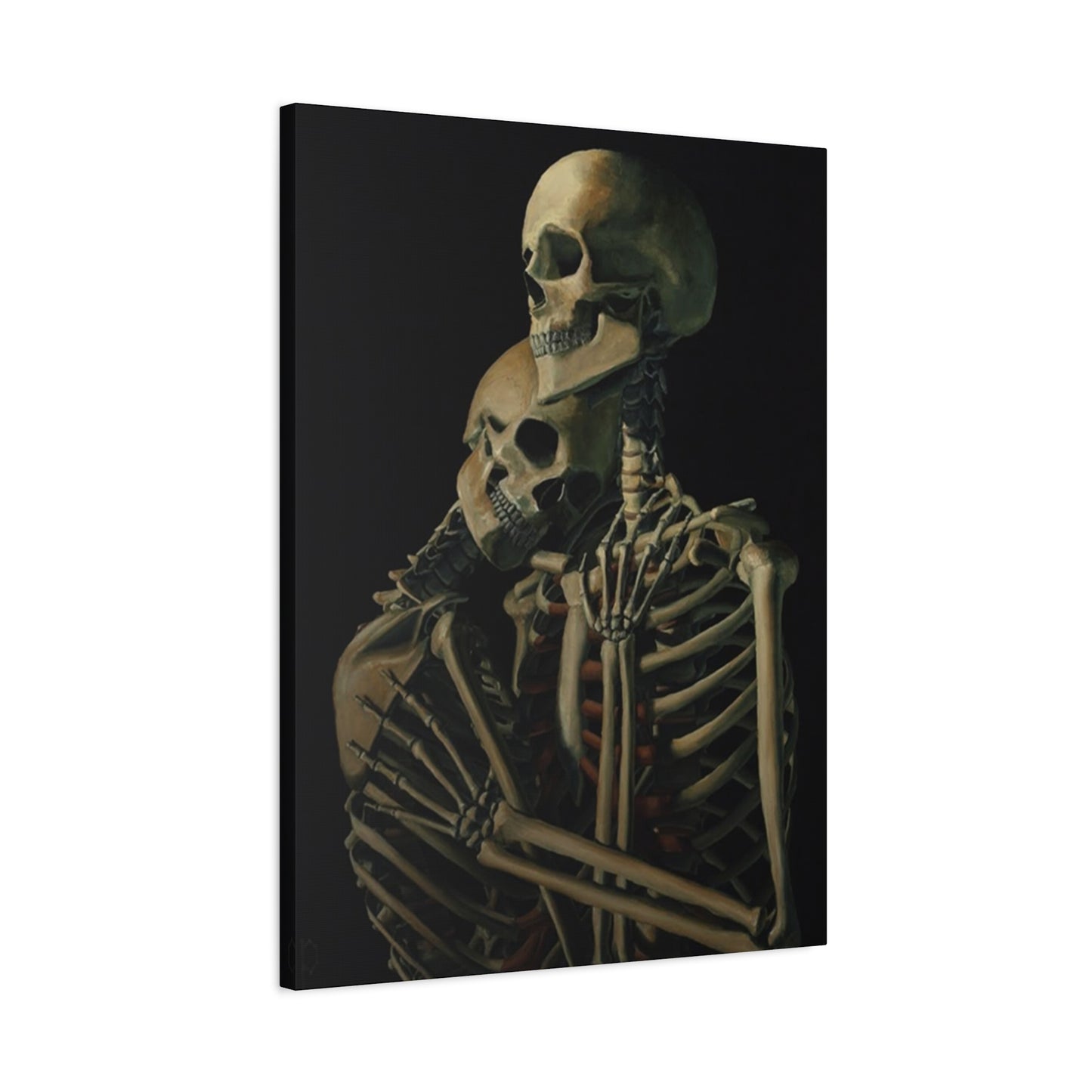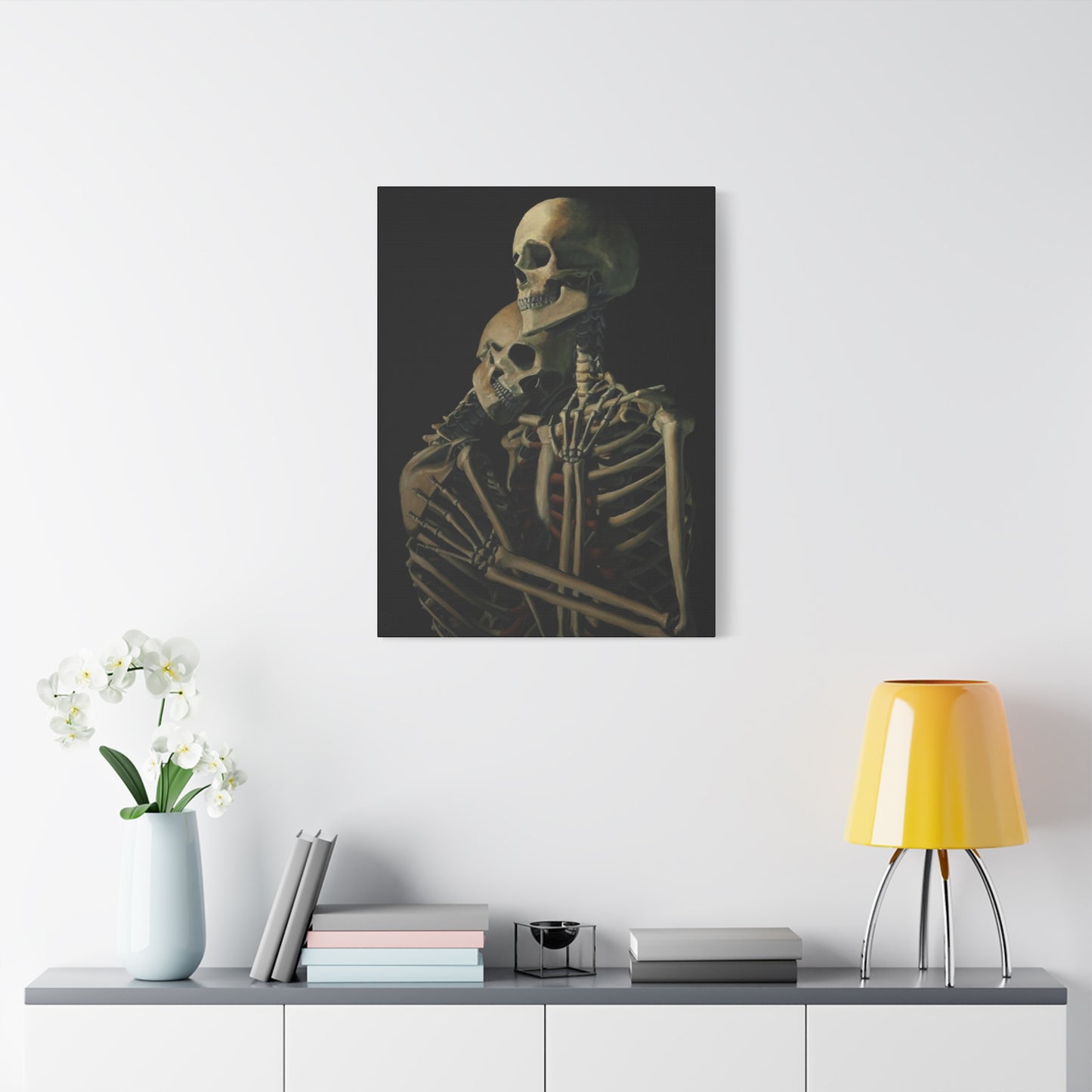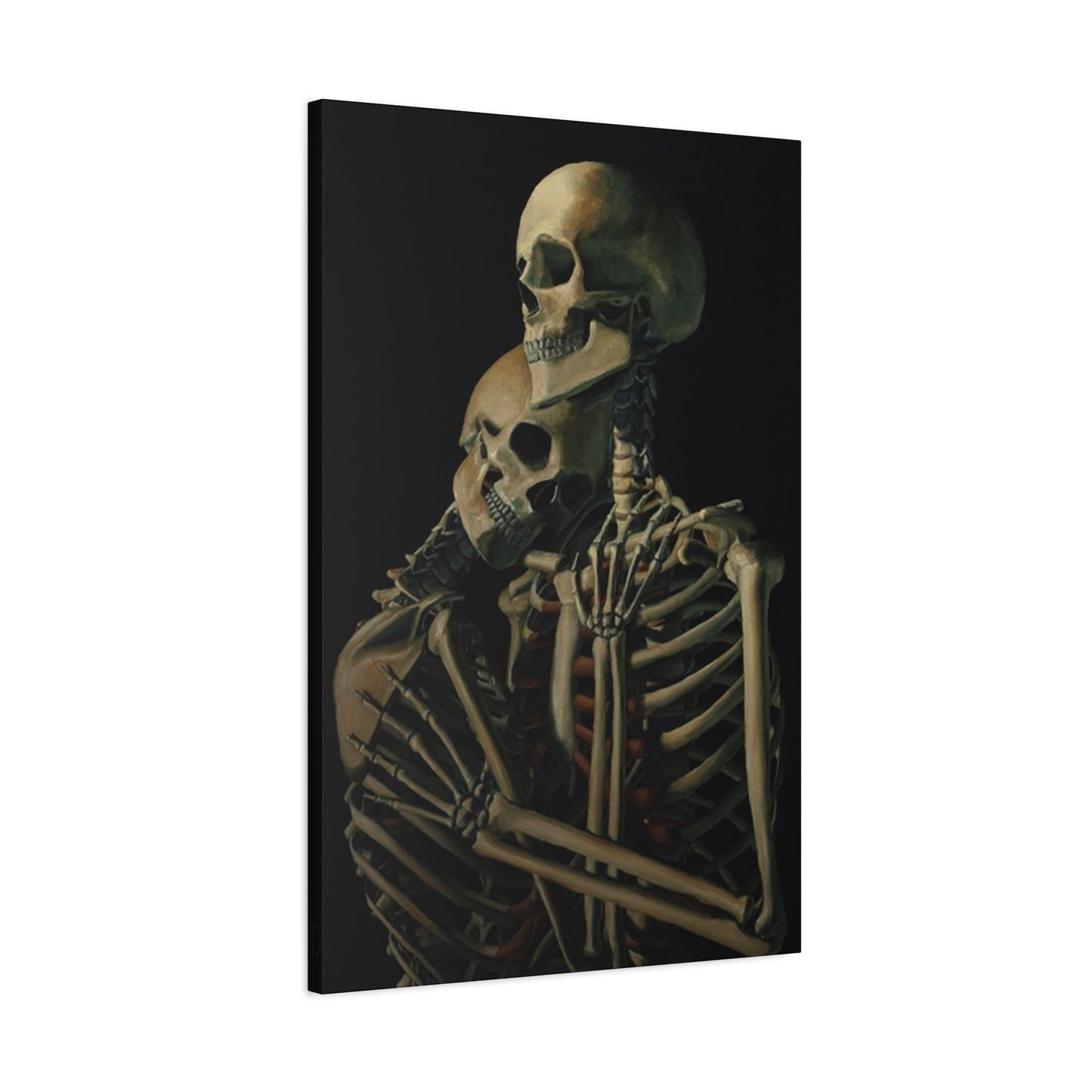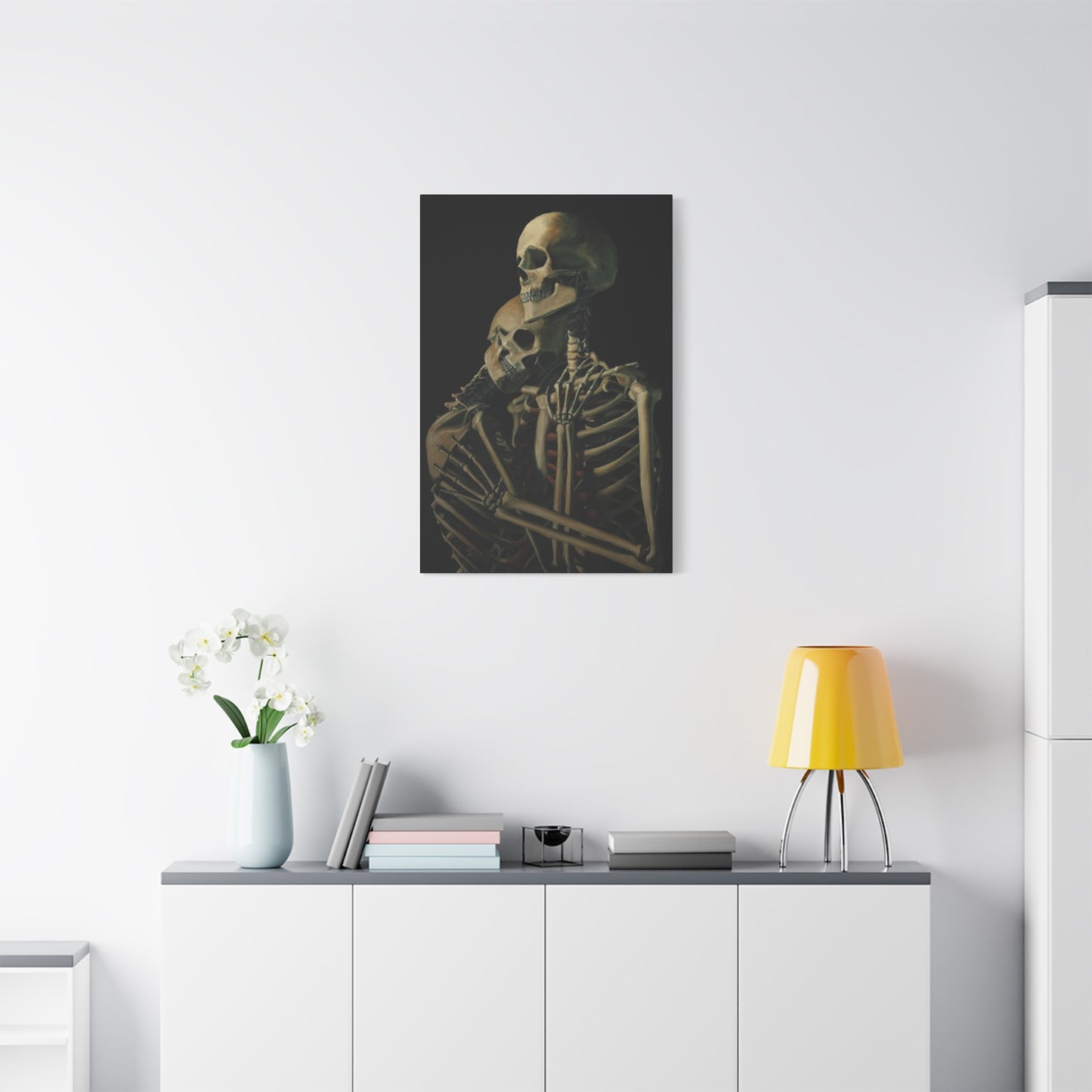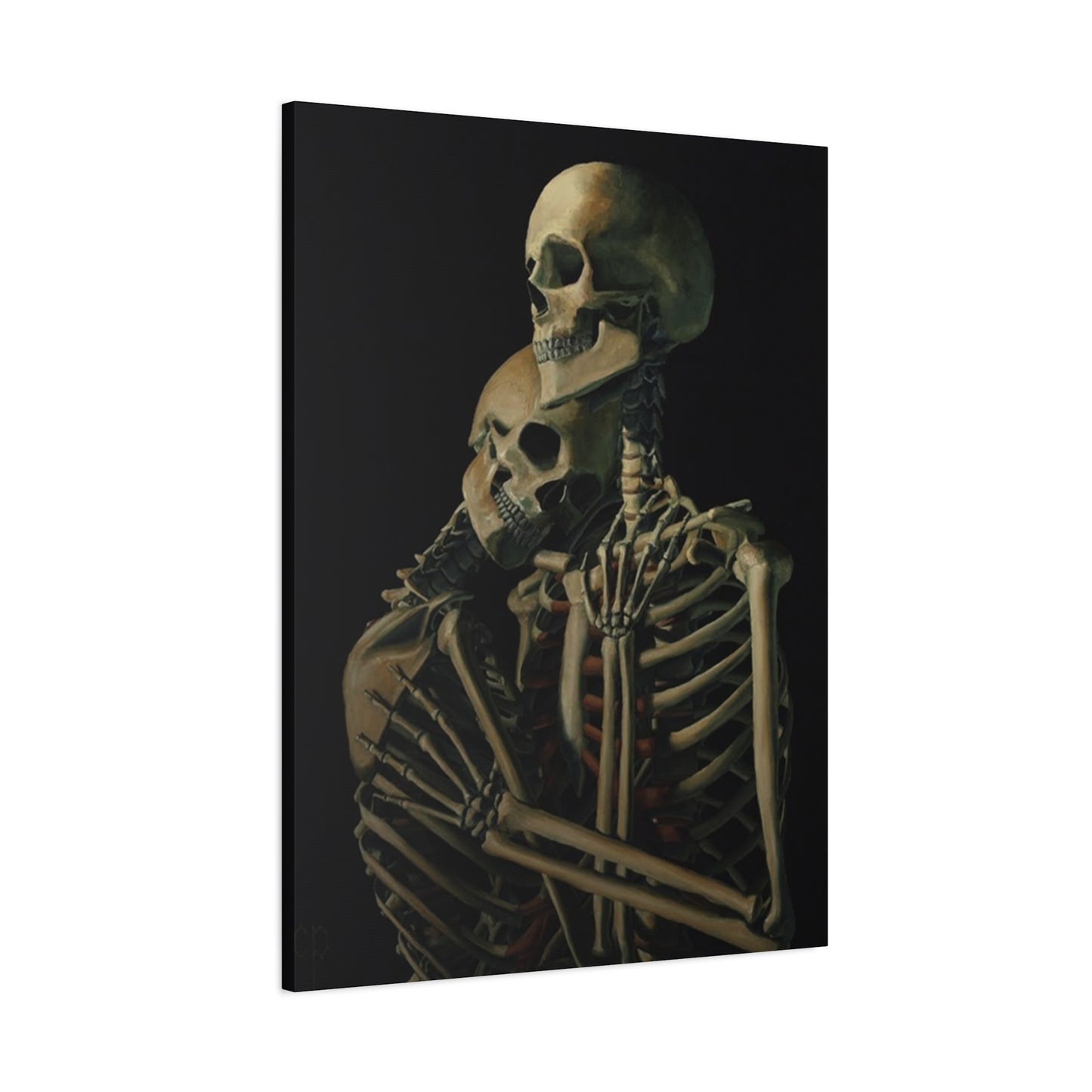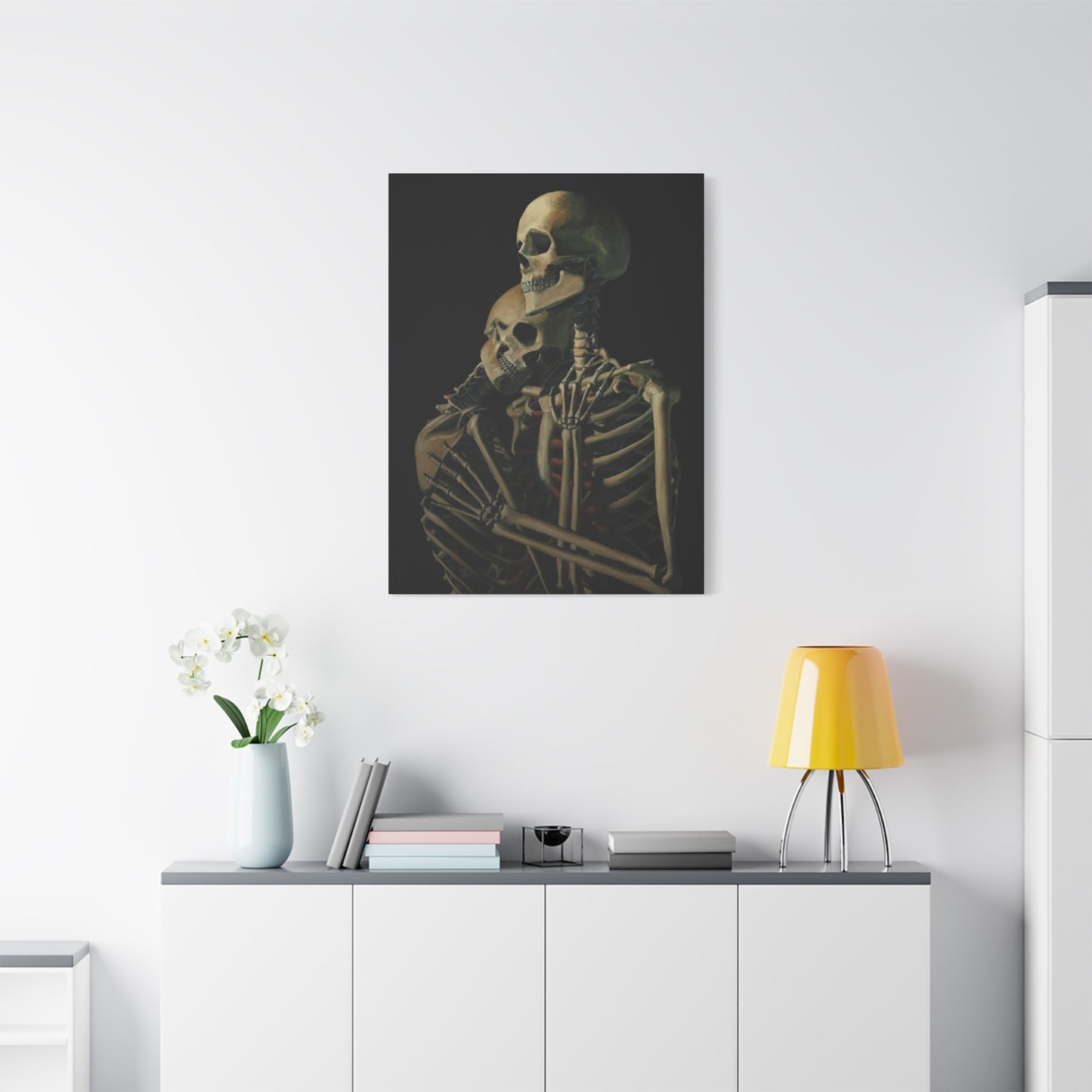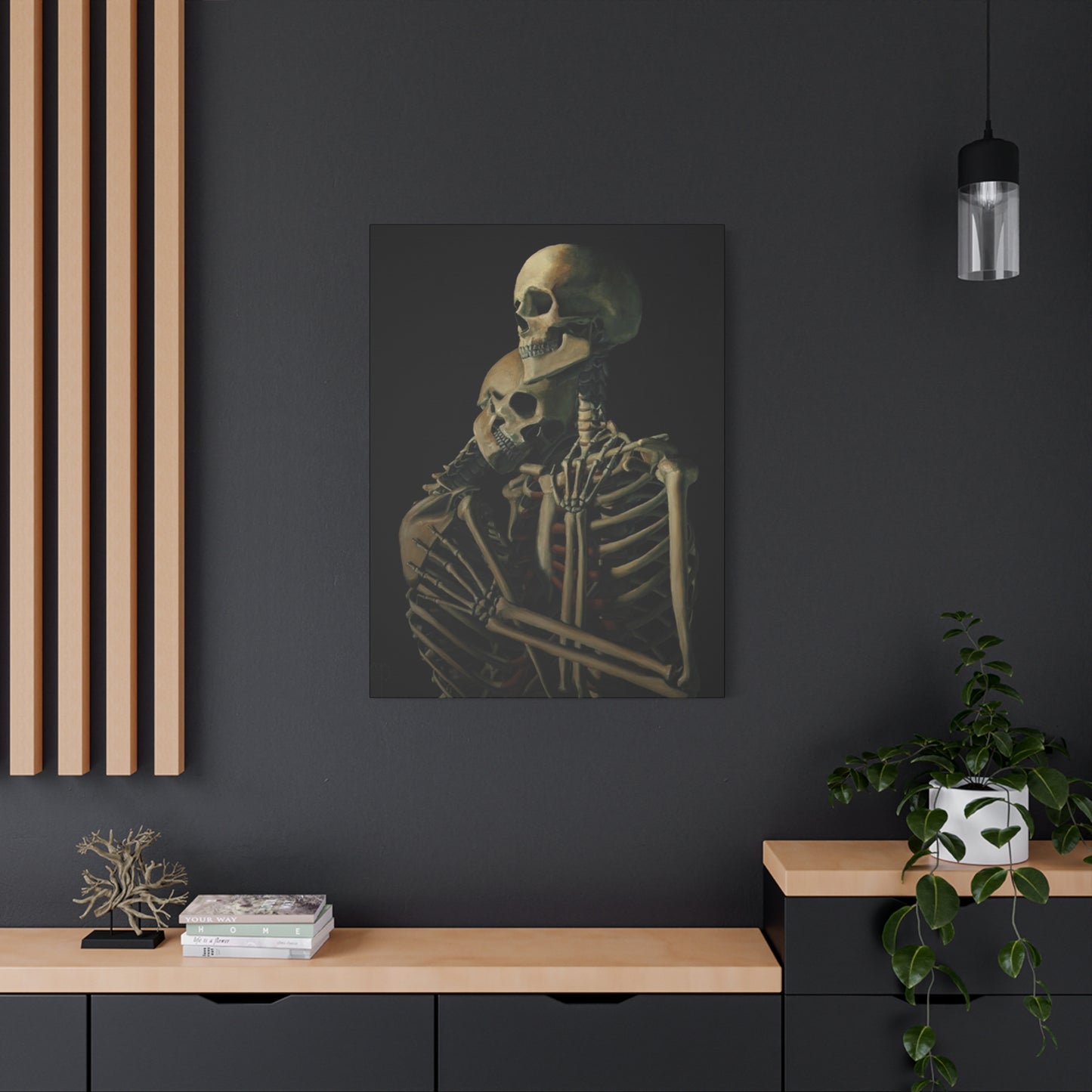Skeleton Couple Hugging Wall Art Canvas Prints: Gothic Romance for Your Home Décor
The fusion of love and mortality has captivated artists and romantics throughout history. Skeleton couple hugging wall art canvas prints represent this timeless fascination, bringing together the beauty of eternal devotion with the stark reality of our mortal existence. These striking pieces have surged in popularity among homeowners seeking to express their unique personalities through bold, meaningful décor choices.
Canvas prints featuring embracing skeletal figures offer more than just visual appeal. They serve as conversation starters, philosophical statements, and powerful symbols of love that transcends physical boundaries. Whether you appreciate gothic aesthetics, Day of the Dead traditions, or simply enjoy art that challenges conventional notions of romance, skeleton couple artwork provides a compelling addition to your living environment.
The beauty of these pieces lies in their versatility. From minimalist black-and-white designs to vibrant, colorful interpretations inspired by Mexican folk art, skeleton couple canvas prints accommodate diverse tastes and decorating styles. Modern printing technology ensures these images maintain exceptional clarity and depth, transforming your blank walls into galleries of meaningful expression.
As we explore the world of skeleton couple hugging wall art, we'll examine the cultural significance behind these images, discuss various artistic styles and interpretations, provide guidance on selecting the perfect piece for your home, and offer practical advice on display and maintenance. This comprehensive guide will help you appreciate the deeper meanings behind these captivating artworks while making informed decisions about incorporating them into your personal environment.
The Cultural and Historical Significance Behind Skeleton Imagery in Romantic Art
Throughout human civilization, skeleton imagery has held profound cultural significance across numerous societies and time periods. The representation of skeletal figures in art dates back thousands of years, serving various purposes from memento mori reminders in medieval Europe to celebratory symbols in pre-Columbian Mesoamerican cultures. When combined with themes of love and partnership, skeleton imagery takes on additional layers of meaning that resonate with contemporary audiences.
In medieval and Renaissance Europe, skeleton imagery frequently appeared in religious art and literature as a reminder of mortality. Artists incorporated dancing skeletons and skeletal figures into their works to emphasize the fleeting nature of earthly existence and the importance of spiritual preparation for the afterlife. These representations, while somber in tone, laid the groundwork for later artistic interpretations that would embrace skeletons as symbols rather than merely morbid warnings.
The Mexican tradition of Día de los Muertos, or Day of the Dead, revolutionized the way Western audiences perceived skeleton imagery. Rather than viewing death as an ending to be feared, this cultural celebration treats it as a natural continuation of life's journey. Skeleton figures, particularly the iconic calaveras, became symbols of joy, remembrance, and connection between the living and deceased. Couples depicted as skeletons during these festivities represent the belief that love continues beyond physical death, a concept that deeply influences modern skeleton couple artwork.
Gothic subculture, emerging in the late twentieth century, embraced skeleton imagery as part of its aesthetic vocabulary. This movement celebrated the darker aspects of human experience, including mortality, melancholy, and the macabre, while simultaneously finding beauty in these themes. Gothic art often features romantic skeleton couples as representations of eternal love, devotion that persists through death, and the rejection of superficial beauty standards in favor of deeper emotional connections.
Contemporary artists have synthesized these various cultural influences to create skeleton couple artwork that speaks to modern sensibilities. Today's pieces often blend traditional symbolism with current artistic techniques, resulting in images that honor historical meanings while appealing to contemporary tastes. The skeleton couple hugging motif specifically emphasizes intimacy, vulnerability, and the human need for connection, themes that remain universally relevant regardless of cultural background.
The philosophical implications of skeleton couple art extend beyond mere decoration. These images invite viewers to contemplate profound questions about the nature of love, the impermanence of physical existence, and the possibility of connections that transcend bodily form. By displaying skeleton couple canvas prints, individuals make statements about their values, their relationship to mortality, and their appreciation for love in its purest, most enduring form.
Academic interest in memento mori art has increased in recent decades, with scholars examining how death-related imagery functions in contemporary society. Skeleton couple art fits within this broader category, serving as a modern interpretation of age-old human concerns about mortality and meaning. Unlike earlier memento mori works that often carried judgmental or fearful tones, contemporary skeleton couple pieces typically celebrate life and relationships rather than inducing anxiety about death.
The psychological appeal of skeleton imagery in romantic contexts relates to its ability to strip away superficial concerns and focus on essential truths. Skeletons represent the core structure that supports all human bodies, regardless of external appearance, social status, or other differentiating factors. When depicted as couples, these skeletal figures emphasize that genuine connection exists at a fundamental level, unaffected by the temporary qualities that often preoccupy living individuals.
Cross-cultural appreciation for skeleton couple art demonstrates how certain themes achieve universal resonance despite originating in specific cultural contexts. Artists from diverse backgrounds have created their own interpretations of embracing skeletal couples, each bringing unique perspectives informed by their cultural heritage while tapping into shared human experiences of love, loss, and longing for meaningful connection.
Artistic Styles and Design Variations in Skeleton Couple Canvas Prints
The market for skeleton couple canvas prints offers remarkable variety, encompassing numerous artistic styles that cater to different aesthetic preferences and decorating philosophies. Minimalist interpretations feature clean lines, limited color palettes, and simplified skeletal forms that emphasize elegance and restraint. These designs work particularly well in contemporary homes where simplicity and visual clarity take precedence over elaborate ornamentation.
Black-and-white skeleton couple prints deliver powerful visual impact through stark contrast and careful attention to anatomical detail. Artists working in this monochromatic tradition often focus on the interplay of light and shadow, creating depth and dimension that brings skeletal figures to life. The absence of color directs viewer attention to composition, form, and emotional content, resulting in pieces that feel both classic and timeless.
Colorful skeleton couple artwork draws inspiration from Mexican folk art traditions, incorporating vibrant hues, intricate patterns, and decorative elements that transform skeletal figures into joyful celebrations of life and love. These pieces often feature flowers, geometric designs, and other ornamental details that create visual richness and complexity. The bright color schemes associated with this style inject energy and personality into any room, making them popular choices for individuals who embrace bold decorating choices.
Watercolor skeleton couple prints offer softer, more romantic interpretations of the theme. The fluid, translucent qualities of watercolor painting create ethereal effects that emphasize the spiritual and emotional dimensions of skeletal embraces. These pieces often incorporate gentle color gradients, dreamy backgrounds, and delicate details that evoke feelings of tenderness and poignancy.
Gothic and Victorian-inspired skeleton couple artwork features ornate frames, vintage typography, and design elements reminiscent of nineteenth-century mourning art. These pieces often incorporate roses, vintage patterns, and antiqued finishes that create a sense of historical depth and romantic melancholy. The Victorian fascination with death and mourning rituals informs these designs, resulting in artwork that feels both nostalgic and mysteriously beautiful.
Abstract interpretations of skeleton couples push beyond literal representation, using skeletal forms as starting points for more experimental artistic explorations. These pieces might deconstruct skeletal figures into geometric shapes, blend them with surrealist elements, or present them in unexpected contexts that challenge viewer expectations and encourage deeper contemplation.
Photorealistic skeleton couple prints showcase technical mastery, presenting anatomically accurate skeletal figures with meticulous attention to detail. These pieces appeal to viewers who appreciate scientific precision and naturalistic representation, offering educational value alongside aesthetic appeal. The combination of scientific accuracy with romantic composition creates intriguing tension between objective reality and subjective emotion.
Contemporary digital art techniques have expanded the possibilities for skeleton couple canvas prints, enabling artists to create hybrid images that combine photography, illustration, and digital manipulation. These modern approaches result in unique pieces that couldn't exist without current technology, featuring effects like double exposure, digital painting techniques, and seamlessly blended elements from multiple sources.
Vintage-style skeleton couple prints emulate aged photographs or antique illustrations, complete with faded colors, paper textures, and distressed effects that suggest historical artifacts. These designs appeal to nostalgia while maintaining the timeless quality that makes skeleton imagery perpetually relevant. The vintage aesthetic softens the potentially jarring nature of skeletal figures, making them more approachable for viewers who might otherwise find such imagery uncomfortable.
Three-dimensional effects in skeleton couple canvas prints create impressive depth and visual interest. Some artists use shading and perspective techniques to make skeletal figures appear to emerge from or recede into the canvas surface. Others incorporate actual textural elements during the printing process, resulting in pieces that engage both visual and tactile senses.
Selecting the Perfect Skeleton Couple Canvas Print for Your Living Areas
Choosing the right skeleton couple canvas print requires careful consideration of multiple factors, beginning with the overall aesthetic of your existing décor. Homes decorated in modern minimalist styles benefit from clean-lined, monochromatic skeleton prints that complement rather than compete with the surrounding simplicity. The restrained elegance of black-and-white skeletal embraces enhances contemporary settings without introducing visual clutter or tonal discord.
Traditional and classic home environments can incorporate skeleton couple artwork through pieces that feature vintage styling, ornate framing, or muted color palettes that harmonize with established décor elements. Victorian-inspired skeleton prints work particularly well in homes with antique furniture, rich wood tones, and traditional architectural details, creating cohesive visual narratives that honor both past and present aesthetic sensibilities.
Eclectic decorating approaches welcome the boldest, most colorful skeleton couple canvas prints. Homes that already feature diverse artistic styles, mixed patterns, and varied color schemes can accommodate vibrant Day of the Dead-inspired pieces without creating visual chaos. In these settings, skeleton artwork adds another layer of personality and interest to already dynamic environments.
Size considerations play crucial roles in selecting appropriate canvas prints. Large-scale skeleton couple artwork makes powerful focal points in living rooms, above sofas, or on prominent walls where dramatic impact serves the overall design strategy. These substantial pieces command attention and set tones for entire rooms, making them suitable for individuals who want their artwork to serve as primary decorating elements rather than subtle accents.
Medium-sized skeleton couple prints offer versatility, working effectively in various locations throughout homes. These moderately scaled pieces fit comfortably in bedrooms, dining areas, hallways, and home offices without overwhelming their surroundings. Their manageable dimensions make them easier to incorporate into existing decorating schemes while still providing meaningful visual presence.
Small skeleton couple canvas prints excel in creating gallery walls, where multiple coordinated pieces combine to form larger visual statements. Collections of related prints allow for narrative development and thematic exploration that single pieces cannot achieve. Gallery walls featuring skeleton couple artwork at various scales and in complementary styles create dynamic, personalized displays that reflect individual tastes and values.
Color coordination between skeleton couple prints and existing room palettes ensures visual harmony. Artwork featuring colors already present in furnishings, window treatments, or other decorative elements creates cohesive environments where all components work together effectively. Alternatively, skeleton prints can introduce accent colors that provide contrast and visual interest without creating jarring disconnections from established color schemes.
The emotional tone of skeleton couple artwork matters significantly in selection decisions. Some pieces emphasize romantic tenderness, depicting skeletal figures in gentle embraces that communicate love and devotion. Others present more dramatic or gothic interpretations that convey intensity, passion, or melancholic beauty. Matching the emotional quality of artwork to the intended atmosphere of each room ensures that decorative choices support rather than undermine desired experiential outcomes.
Personal connection to specific skeleton couple designs should guide final selection decisions. Artwork that resonates emotionally, reflects personal values, or connects to meaningful experiences provides deeper satisfaction than pieces chosen solely for aesthetic coordination. The best decorating choices combine visual appropriateness with personal significance, resulting in living environments that feel authentically reflective of inhabitants' identities.
Room function influences appropriate skeleton couple artwork selections. Bedrooms might benefit from more intimate, romantic skeleton prints that reinforce themes of partnership and enduring connection. Living and entertaining areas can accommodate bolder, more conversation-provoking pieces that serve as discussion starters and expressions of household personality. Private studies or personal retreats might feature more contemplative or philosophical skeleton couple artwork that encourages reflection.
Incorporating Gothic and Alternative Aesthetics Through Skeleton Canvas Art
Gothic aesthetic principles emphasize the beauty found in darkness, mystery, and unconventional subject matter. Skeleton couple canvas prints naturally align with these values, making them ideal decorative elements for individuals who embrace alternative styling approaches. The gothic appreciation for mortality as an intrinsic part of existence rather than a topic to avoid finds perfect expression in skeleton imagery that confronts death while celebrating love.
Layering techniques common in gothic decorating strategies can enhance the impact of skeleton couple artwork. Placing prints against richly colored walls in deep burgundy, forest green, midnight blue, or classic black creates dramatic backdrops that intensify the visual power of skeletal figures. Velvet or textured wall coverings add additional dimension, making skeleton couple prints feel integrated into luxurious, multifaceted environments rather than merely attached to flat surfaces.
Complementary decorative elements amplify the gothic character of skeleton couple canvas prints. Ornate frames in dark metals or distressed finishes provide period-appropriate presentations that honor gothic aesthetic traditions. Candlesticks, vintage books, dried flowers, and other accessories with romantic or Victorian associations create cohesive vignettes where skeleton artwork serves as focal points within larger decorative narratives.
Lighting considerations significantly affect how skeleton couple prints appear in gothic settings. Soft, indirect lighting from vintage-style fixtures creates atmospheric conditions that enhance the mysterious, romantic qualities of skeletal imagery. Strategic placement of candles or subtle accent lighting can cast shadows that add depth and drama, transforming static prints into dynamic visual experiences that change throughout the day.
Alternative subcultures beyond gothic traditions also find expression through skeleton couple artwork. Punk aesthetics, with their confrontational approach to conventional beauty standards and social norms, align well with skeleton imagery that challenges mainstream decorating expectations. Rock and metal music fans often appreciate the edgy, rebellious quality of skeleton couple prints, seeing them as reflections of musical interests and alternative lifestyle choices.
Steampunk decorating approaches can incorporate skeleton couple canvas prints by selecting pieces that feature mechanical elements, vintage scientific illustrations, or Victorian-era styling. The steampunk aesthetic celebrates the intersection of historical and fantastical, making skeleton artwork featuring gears, clockwork elements, or antique medical diagram styling particularly appropriate for this decorating philosophy.
Bohemian decorating strategies welcome skeleton couple prints as expressions of artistic freedom, cultural appreciation, and rejection of conventional taste. Homes decorated in boho styles often feature eclectic collections of meaningful objects from various cultural traditions. Skeleton couple artwork inspired by Day of the Dead celebrations fits naturally into these environments, honoring specific cultural heritage while contributing to the overall aesthetic of creative individuality.
Alternative decorating approaches often prioritize personal expression over adherence to design rules, making them particularly receptive to potentially controversial artistic choices like skeleton imagery. Individuals who embrace alternative aesthetics typically view their living environments as extensions of personal identity rather than showcases of conventional taste. Skeleton couple canvas prints serve these goals by making clear statements about values, interests, and willingness to embrace unconventional beauty.
Creating thematic consistency in alternatively styled homes requires thoughtful curation of decorative elements. Skeleton couple prints should coordinate with other artwork, textiles, and accessories to create unified visual narratives rather than appearing as isolated oddities. When skeleton imagery appears alongside complementary pieces featuring related themes, symbolism, or aesthetic approaches, the overall environment feels intentionally crafted rather than haphazardly assembled.
Balance remains important even in alternative decorating schemes. While gothic and alternative aesthetics embrace darkness and unconventional imagery, successful implementation requires careful attention to proportion, scale, and visual weight. Skeleton couple canvas prints contribute to this balance by providing focal points around which other decorative elements can orbit, creating structured yet expressive living environments.
The Symbolism of Eternal Love in Skeletal Embrace Artwork
Skeleton couple artwork depicting figures in embrace carries profound symbolic meaning related to the nature of love and human connection. By representing couples as skeletons, artists strip away superficial attributes that often receive disproportionate attention in romantic relationships. Physical appearance, material possessions, social status, and other external factors disappear, leaving only the essential framework that supports human existence. This reduction to fundamental structures emphasizes that authentic love exists independent of temporary, changeable qualities.
The embrace itself communicates vulnerability, trust, and intimacy. Skeletal figures wrapped around each other demonstrate the human need for closeness and connection that persists regardless of physical mortality. The absence of flesh makes these embraces simultaneously more abstract and more universal, allowing viewers to project their own experiences and emotions onto the skeletal forms without distraction from specific physical characteristics.
Philosophical concepts of eternal love find visual expression in skeleton couple imagery. Many spiritual and religious traditions propose that genuine love transcends physical death, continuing in afterlife realms or through spiritual bonds that outlast bodily existence. Skeleton couples embracing represent this belief, suggesting that relationships formed in life carry forward beyond the grave. This interpretation provides comfort to those grieving lost partners while affirming the enduring significance of love.
Cultural variations in interpreting skeleton couple symbolism reflect different attitudes toward death and relationships. Mexican Day of the Dead traditions view skeletal couples as joyful representations of reunion in the afterlife, where deceased loved ones gather to celebrate life's continuing cycles. This perspective emphasizes continuity, community, and the integration of death into life's natural rhythms rather than treating mortality as an ending to fear or avoid.
Gothic romantic traditions interpret skeleton couple imagery through lenses of beautiful melancholy and poetic darkness. Within this framework, skeletal embraces represent the bittersweet nature of love, acknowledging that all relationships face mortality's inevitability while celebrating the profound beauty of connection despite its temporary nature. This perspective finds poignancy in impermanence, viewing awareness of mortality as intensifying rather than diminishing love's significance.
Psychological interpretation of skeleton couple symbolism reveals deeper truths about human relationship needs. The embrace between skeletal figures represents the desire for acceptance and connection at the most fundamental level of existence. By depicting love between beings reduced to their essential structures, this imagery affirms the possibility of being truly known and valued for inherent qualities rather than external presentations.
Contemporary secular interpretations often view skeleton couple artwork as celebrations of authentic partnership. In an age of social media presentations and carefully curated public images, skeleton imagery reminds viewers that genuine relationships develop through mutual understanding of complete, complex human beings rather than idealized surfaces. The skeletal embrace becomes a statement against superficiality, honoring depth and substance in romantic connections.
Memorial and commemorative functions of skeleton couple artwork provide meaningful ways to honor deceased partners or relationships ended by death. Displaying these pieces allows individuals to acknowledge their ongoing emotional connections to lost loved ones while finding beauty in remembrance. The skeleton couple serves as a visual representation of bonds that death cannot sever, offering solace and affirmation of love's lasting impact.
Artistic exploration of mortality through romantic skeleton imagery challenges viewers to confront uncomfortable truths about human existence. By combining death-related symbolism with representations of love, artists create productive tension that encourages contemplation of life's most significant questions. This juxtaposition prompts viewers to consider their own relationships, values, and responses to mortality in ways that purely pleasant imagery rarely accomplishes.
The universality of skeleton couple symbolism transcends specific cultural contexts, speaking to fundamental human experiences of love and loss that occur across all societies. While particular artistic traditions bring unique perspectives to skeletal imagery, the core themes of enduring connection and love beyond physical boundaries resonate with viewers regardless of cultural background, making skeleton couple artwork genuinely cross-cultural in its appeal.
Canvas Print Quality Considerations for Skeleton Couple Artwork
Canvas print quality dramatically affects the visual impact and longevity of skeleton couple artwork. High-quality printing processes produce images with exceptional clarity, accurate color representation, and subtle gradations that bring artistic vision to life. Professional-grade canvas prints feature sharp details that maintain integrity even when viewed at close range, ensuring that intricate elements within skeleton couple designs remain visible and impactful.
Canvas material selection influences both appearance and durability. Premium cotton canvas provides superior texture, weight, and longevity compared to synthetic alternatives. Cotton canvas accepts ink more effectively, resulting in richer colors and better detail retention. The natural texture of quality canvas adds depth to skeleton couple prints, creating subtle variations in surface appearance that enhance visual interest without detracting from the underlying image.
Stretching and mounting techniques determine how canvas prints maintain their appearance over time. Professional gallery wrapping, where canvas extends around wooden frame edges, creates clean, finished presentations suitable for hanging without additional framing. Proper tensioning prevents sagging and warping that can develop in poorly stretched canvas, ensuring skeleton couple artwork remains taut and visually appealing for years.
Ink quality and printing technology affect color vibrancy, accuracy, and fade resistance in canvas prints. Archival-quality pigment inks resist fading from light exposure and environmental factors, maintaining the intended appearance of skeleton couple artwork for decades. UV-resistant inks provide additional protection against sun damage, particularly important for pieces displayed in rooms with significant natural light exposure.
Color calibration in the printing process ensures that final canvas prints accurately represent artists' intentions. Professional print services use color management systems that account for differences between digital displays and physical prints, producing skeleton couple artwork that matches expected appearance. This calibration prevents disappointing color shifts that can occur when images translate from screen to canvas without proper adjustment.
Resolution and file quality directly impact print clarity and detail. Skeleton couple artwork printed from high-resolution source files maintains sharpness and definition across all image areas, while low-resolution files produce muddy, pixelated results that diminish artistic impact. Professional artists and print services ensure adequate resolution for intended print sizes, preventing quality degradation that undermines visual effectiveness.
Coating and finishing options provide additional protection and aesthetic effects for canvas prints. Protective coatings shield skeleton couple artwork from dust, moisture, and physical damage while enhancing color depth and vibrancy. Matte finishes reduce glare and reflections, making prints easier to view in various lighting conditions. Glossy finishes intensify colors and create more dramatic visual impact, though they may produce reflections in certain lighting situations.
Frame and edge finishing choices affect the overall presentation of canvas prints. Floating frames create modern, gallery-style displays that showcase skeleton couple artwork with contemporary elegance. Traditional frames provide structure and formality that suit classic decorating approaches. Frameless presentations emphasize the artwork itself, allowing skeleton couple prints to integrate seamlessly into minimalist environments.
Print thickness and depth create three-dimensional presence that flat posters cannot match. Canvas stretched over substantial wooden frames projects from walls, creating shadow effects and physical presence that enhance visual impact. This dimensional quality makes skeleton couple canvas prints feel more substantial and artwork-like compared to two-dimensional alternatives.
Vendor reputation and customer reviews provide valuable information about canvas print quality. Established printing services with consistent positive feedback typically deliver reliable results that meet or exceed expectations. Reading reviews specific to skeleton couple prints or similar artwork helps identify vendors capable of accurately reproducing the specific characteristics that make this imagery effective.
Display Strategies for Maximizing Impact of Skeleton Couple Canvas Prints
Strategic placement of skeleton couple canvas prints significantly influences their visual impact and effectiveness within living environments. Central walls in primary rooms provide ideal locations for these statement pieces, where they command attention and set tones for entire areas. Above seating furniture, mantels, or other architectural focal points, skeleton couple artwork becomes integral to room design rather than merely decorative afterthought.
Height considerations affect how viewers engage with skeleton couple prints. Artwork positioned at average eye level creates comfortable viewing experiences that allow proper appreciation of details and composition. In rooms where people primarily stand, this typically means centering prints approximately sixty inches from floor to artwork center. In areas where people sit, slightly lower positioning accommodates the changed sight lines of seated viewers.
Gallery wall arrangements allow for creative combinations of multiple skeleton couple prints or integration of skeleton artwork with complementary pieces. Symmetrical gallery walls create formal, balanced presentations suitable for traditional settings, while asymmetrical arrangements generate dynamic energy appropriate for contemporary or eclectic environments. Planning gallery wall layouts before hanging ensures cohesive results that appear intentionally designed rather than randomly assembled.
Lighting dramatically affects how skeleton couple canvas prints appear. Natural light showcases artwork during daytime hours but requires consideration of fading potential from UV exposure. Dedicated picture lighting provides consistent illumination that highlights artwork regardless of time or ambient conditions. Adjustable lighting systems allow customization of brightness and direction, creating different moods and emphasizing various aspects of skeleton couple imagery.
Negative space around skeleton couple prints allows them to breathe visually, preventing cluttered appearances that diminish individual piece impact. Adequate spacing between artwork and adjacent furniture, decorative objects, or architectural elements creates visual separation that helps each component maintain its distinct presence. This breathing room becomes particularly important with dramatic or emotionally intense imagery like embracing skeletons.
Backdrop considerations influence how skeleton couple prints read within their environments. Neutral wall colors provide versatile backgrounds that allow artwork to command attention without color competition. Bold wall colors create dramatic contexts that can either enhance or overwhelm skeleton prints depending on specific color relationships and artistic styles. Testing how particular skeleton couple artwork appears against planned wall colors prevents disappointing discoveries after installation.
Grouping strategies for multiple skeleton couple prints create narrative opportunities and visual rhythms. Triptych arrangements tell stories across three panels, allowing for sequential or thematic development that single pieces cannot achieve. Matching sizes create uniformity and formality, while varied sizes generate movement and hierarchy that guide viewer attention through deliberate visual pathways.
Seasonal rotation allows fresh perspectives on skeleton couple artwork and prevents visual fatigue. Homes with multiple prints can rotate which pieces occupy prominent display positions, maintaining interest and allowing different works to receive featured attention. This approach maximizes the value of entire collections while keeping living environments dynamic and responsive to changing seasons or moods.
Architectural features provide natural display opportunities for skeleton couple canvas prints. Alcoves, wall niches, and built-in shelving offer defined spaces that frame artwork and create curated presentations. Hallways and stairways, often neglected in decorating plans, benefit from skeleton couple prints that transform transitional areas into gallery-like experiences that enhance overall home character.
Relationship to other decorative elements requires consideration when displaying skeleton couple prints. Artwork should coordinate with rather than compete against other visual focal points like fireplaces, windows, or statement furniture pieces. Achieving balance between skeleton couple prints and other room features creates harmonious environments where all components contribute to unified aesthetic experiences.
Combining Skeleton Couple Prints with Other Decorative Elements
Creating cohesive decorating schemes around skeleton couple canvas prints requires thoughtful selection of complementary decorative elements. Textiles including throw pillows, blankets, and curtains in coordinating colors and patterns tie skeleton artwork into broader room designs. Selecting fabrics that echo colors within skeleton couple prints creates visual connections that make artwork feel integrated rather than isolated on walls.
Furniture choices affect how skeleton couple prints function within their environments. Dark wood furniture with gothic or Victorian characteristics complements skeleton artwork with similar aesthetic qualities, creating period-appropriate settings that honor the historical roots of memento mori imagery. Modern furniture in sleek profiles and neutral tones allows skeleton couple prints to serve as primary visual interest sources without competing against elaborate furniture designs.
Accessory selection amplifies themes established by skeleton couple artwork. Decorative skulls, vintage medical illustrations, antique books, and gothic candleholders create thematic continuity that reinforces the aesthetic choices represented by skeleton prints. These supporting elements transform individual artwork pieces into components of larger decorative narratives that communicate clear stylistic visions.
Plant life provides appealing contrast to skeleton couple imagery, introducing organic vitality that balances mortality-focused artwork. Lush greenery, flowering plants, or dramatic botanical specimens create life-death juxtapositions that add philosophical depth to room designs. The combination of living plants with skeletal imagery acknowledges both sides of existence's cycle, creating more complete and nuanced environmental statements.
Metallic accents in copper, brass, bronze, or black iron complement skeleton couple prints effectively. Metal candle holders, picture frames, decorative objects, and light fixtures add texture and visual interest while maintaining tonal harmony with darker, gothic-inspired skeleton artwork. The cool, industrial quality of metal provides counterbalance to canvas prints' softer, more romantic elements.
Books and literary references enhance the intellectual dimension of skeleton couple displays. Collections of poetry, gothic literature, philosophy, or art history books positioned near skeleton prints suggest thoughtful engagement with themes of mortality, love, and artistic tradition. This combination presents inhabitants as cultured individuals who value both aesthetic beauty and intellectual depth.
Mirror placement creates intriguing interactions with skeleton couple artwork. Positioning mirrors to reflect skeleton prints multiplies their presence and creates interesting visual effects that expand perceived room dimensions. Antique mirrors with ornate frames particularly suit gothic or Victorian skeleton couple artwork, adding layers of history and visual complexity to decorating schemes.
Color accent pieces in jewel tones like ruby, emerald, sapphire, or amethyst add richness to environments featuring skeleton couple prints. These saturated colors provide visual excitement without overwhelming darker skeleton imagery, creating balanced color palettes that feel both luxurious and cohesive. Accent colors can appear in small doses through decorative objects, emphasizing their role as supporting rather than dominant elements.
Textile patterns including damask, brocade, velvet, and lace contribute texture and visual interest that enhances skeleton couple artwork. These traditionally luxurious materials add sophistication and depth to room designs, creating layered environments that reward close observation. Pattern selection should coordinate with skeleton print styles, favoring more elaborate designs with Victorian-inspired artwork and simpler patterns with minimalist skeleton pieces.
Sculptural elements including decorative objects, figurines, and three-dimensional art pieces create dimensional variety that complements two-dimensional skeleton couple canvas prints. The interplay between flat artwork and volumetric objects adds visual complexity and creates more engaging environments. Selecting sculptures that echo themes or styles of skeleton prints maintains decorative coherence while expanding aesthetic expression.
Exploring Different Cultural Interpretations of Skeleton Couples in Art
Mexican Day of the Dead traditions offer perhaps the most widely recognized cultural context for skeleton couple imagery. The iconic Catrina figure, originally created by artist José Guadalupe Posada and later popularized by Diego Rivera, represents death as an elegant, feminine presence rather than a fearsome enemy. When depicted as couples, Day of the Dead skeletons celebrate reunion, joy, and the continuation of relationships beyond physical life.
The decorative exuberance characteristic of Day of the Dead celebrations translates beautifully into skeleton couple canvas prints. Bright colors, elaborate floral patterns, and intricate geometric designs transform skeletal figures into festive rather than morbid images. These artistic choices reflect the cultural belief that death represents a transition rather than an ending, and that deceased loved ones remain present in spiritual forms that merit celebration rather than mourning.
European memento mori traditions provide different cultural foundations for skeleton couple imagery. Medieval and Renaissance artists incorporated death imagery into artwork as moral reminders about life's brevity and the importance of spiritual preparation. While these historical contexts emphasized religious messages, contemporary interpretations of memento mori themes focus more on philosophical appreciation of life's preciousness precisely because of its impermanence.
Asian artistic traditions, particularly Japanese aesthetics, offer concepts like mono no aware—the pathos of things—that relate to skeleton couple symbolism. This philosophy finds beauty in transience and impermanence, viewing temporal existence as intensifying rather than diminishing beauty and meaning. Skeleton couple artwork aligns with these perspectives, acknowledging mortality while celebrating the profound beauty of temporary connection.
Celtic traditions and symbolism sometimes appear in skeleton couple artwork through the incorporation of traditional knotwork, triquetra symbols, or references to Celtic mythology. These elements connect skeleton imagery to pre-Christian European spiritual traditions that viewed death as transformation rather than termination. The Celtic emphasis on cycles and continuity resonates with skeleton couple themes of enduring love beyond physical boundaries.
Native American perspectives on death and the afterlife vary significantly among different tribal traditions, but many emphasize continuity between physical and spiritual realms. Contemporary indigenous artists sometimes create skeleton couple imagery that honors these traditional beliefs while engaging with modern artistic movements. These works blend cultural heritage with contemporary artistic vocabulary, creating unique interpretations of skeleton couple themes.
African artistic traditions contribute their own perspectives to skeleton couple imagery through incorporation of ancestral veneration concepts and death-related symbolism from various African cultures. The belief in ancestors' continuing influence on living communities appears in skeleton artwork that emphasizes connection between past and present, depicting skeletal couples as representing both historical relationships and ongoing spiritual presence.
Hindu and Buddhist iconography occasionally influences skeleton couple artwork through incorporation of concepts like impermanence, reincarnation, and the illusory nature of physical existence. Skeleton imagery in these contexts emphasizes the temporary nature of bodily form while affirming eternal spiritual essence. Skeleton couples within Buddhist-influenced art might represent the karmic connections between individuals that persist across multiple lifetimes.
Contemporary multicultural artists create skeleton couple artwork that synthesizes influences from multiple cultural traditions, reflecting increasingly globalized artistic discourse. These hybrid works honor specific cultural roots while acknowledging artists' exposure to diverse traditions and perspectives. The resulting skeleton couple prints speak to universal human experiences while maintaining cultural specificity that enriches their meaning.
Cross-cultural appreciation and appropriation concerns require sensitive navigation when engaging with skeleton couple imagery rooted in specific cultural traditions. Understanding the origins and meanings behind particular artistic styles demonstrates respect for cultural heritage while allowing broader audiences to appreciate and learn from these traditions. Skeleton couple artwork can serve educational functions, introducing viewers to cultural perspectives different from their own and fostering cross-cultural understanding.
Creating and Printing Skeleton Couple Canvas Art
Digital illustration techniques have revolutionized skeleton couple artwork creation, enabling artists to produce highly detailed, professionally finished pieces using digital tools. Graphics tablets and styluses allow precise control over line work, shading, and detail that rivals traditional media while offering advantages like unlimited undo capabilities and non-destructive editing. Digital artists can experiment with multiple versions and variations, refining their skeleton couple compositions until achieving desired results.
Traditional media artwork requires different technical approaches but offers unique aesthetic qualities that digital processes cannot fully replicate. Pencil drawings, pen-and-ink illustrations, watercolors, and acrylic paintings each create distinct visual characteristics that contribute to the final appearance of skeleton couple prints. Even when reproduced digitally, traditionally created artwork retains the hand-made quality that many viewers find appealing and valuable.
Photography-based skeleton couple artwork involves carefully staging skeletal props, models in skeleton costumes, or actual anatomical specimens (where ethically and legally sourced) to create original photographic images. These photographs might undergo extensive digital editing to achieve final artistic visions, but they begin with photographic reality that grounds artwork in physical world representation even when heavily manipulated.
Scanning and digitization processes translate traditionally created artwork into digital formats suitable for canvas printing. High-resolution scanning captures fine details and subtle color variations, ensuring that reproductions maintain fidelity to original works. Professional scanning equipment and techniques prevent common problems like moiré patterns, color shifts, and detail loss that can occur with inadequate digitization.
Color management throughout the creation and printing pipeline ensures that skeleton couple artwork maintains consistent appearance from initial concept through final canvas print. Calibrated monitors, color-managed software, and communication between digital files and printing equipment prevent unwanted color shifts that can dramatically alter artwork appearance. Professional artists and print services invest in color management systems that deliver predictable, accurate results.
Layer-based editing in digital artwork software allows complex skeleton couple compositions with separately controlled elements. Artists can adjust individual components without affecting entire images, facilitating experimentation and refinement. This non-destructive editing approach means mistakes and unsatisfactory choices can be corrected without starting over, increasing creative freedom and reducing artistic risk.
Vector graphics offer advantages for certain skeleton couple designs, particularly those featuring clean lines, solid colors, and geometric elements. Vector artwork maintains perfect sharpness regardless of scaling, allowing single designs to be printed effectively at any size from small prints to large murals. This resolution independence provides flexibility that raster images cannot match when dramatic size changes are required.
Raster images provide better tools for photographic and painted skeleton couple artwork requiring subtle color gradations, complex textures, and soft edges. While resolution-dependent, high-quality raster images captured or created at sufficient resolution produce excellent canvas prints at intended display sizes. Understanding the appropriate resolution for planned print dimensions prevents quality issues from undersized source files.
Test printing allows artists and customers to verify that skeleton couple artwork will appear as expected before committing to final production. Small test prints reveal color accuracy, detail retention, and overall appearance, allowing adjustments before printing full-size versions. This quality control step prevents disappointing results and wasted materials from undetected problems in digital files or printing processes.
Print finishing techniques including stretching, mounting, and protective treatments transform raw printed canvas into complete artwork ready for display. Professional finishing ensures proper tension, secure mounting, clean edges, and appropriate protective coatings. These final steps significantly affect longevity and appearance, making them important considerations in producing high-quality skeleton couple canvas prints.
Conclusion
Skeleton couple hugging wall art canvas prints offer a unique and evocative way to infuse your home décor with gothic romance and profound symbolism. These striking pieces blend elements of love, mortality, and eternal connection, presenting a bold statement that celebrates the beauty of relationships beyond the physical realm. Whether you’re drawn to gothic aesthetics, passionate storytelling, or meaningful artwork, skeleton couple prints provide an artistic focal point that adds depth, intrigue, and emotional resonance to any space.
At the heart of this genre lies a compelling narrative that challenges conventional perceptions of love and life. The image of skeletons embracing transcends the fear often associated with death, transforming it into a powerful symbol of undying affection and the enduring bond between souls. This duality—combining themes of mortality with romance—invites viewers to reflect on the preciousness of human connection and the timeless nature of true love. Displaying such art in your home is a celebration of both life’s fragility and the strength found in intimate relationships.
From an artistic standpoint, skeleton couple hugging wall art often features striking contrasts and intricate details that capture attention and invite closer examination. The stark skeletal forms juxtaposed against rich, dark backgrounds or vibrant accents create a visually dramatic effect that fits perfectly within gothic, alternative, or contemporary décor styles. The canvas medium enhances this impact by lending texture and depth, making the artwork a commanding presence on any wall. Whether hung in a bedroom, living room, or creative studio, these prints add an edgy yet heartfelt dimension to your environment.
Beyond its aesthetic and thematic appeal, skeleton couple hugging wall art resonates on a deeply personal level. For many, it serves as a reminder to cherish the relationships that give life meaning, encouraging mindfulness and gratitude. It can also be a symbol of resilience and hope, signifying that love endures through hardship and even beyond physical existence. This emotional power makes the artwork a meaningful gift for partners, friends, or anyone who appreciates art that speaks to the soul.
Moreover, skeleton couple art aligns well with other gothic and romantic décor elements, allowing for versatile styling options. Pair it with vintage candle holders, dark velvet fabrics, antique frames, or botanical prints featuring night-blooming flowers to create a cohesive and immersive atmosphere. The art’s balance of stark imagery and tender emotion offers flexibility, enabling it to be the centerpiece of a room or part of a curated gallery wall.
In conclusion, skeleton couple hugging wall art canvas prints provide a bold and beautiful way to express gothic romance in your home décor. Their rich symbolism, emotional depth, and striking visual appeal make them ideal for anyone seeking artwork that challenges norms and celebrates love’s eternal nature. By incorporating these prints into your space, you invite a thoughtful and passionate energy that honors the complexities of life and love. Embrace the haunting beauty and heartfelt connection captured in skeleton couple art, and let your walls tell a story of romance that transcends time and form.

















